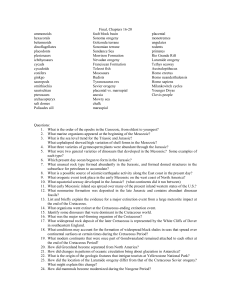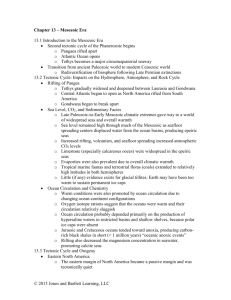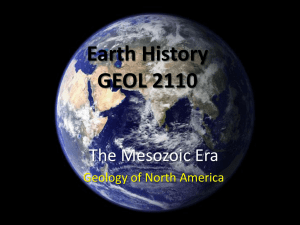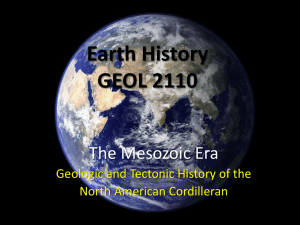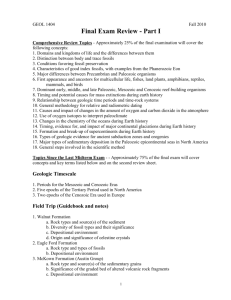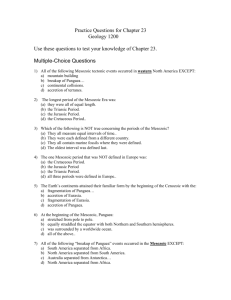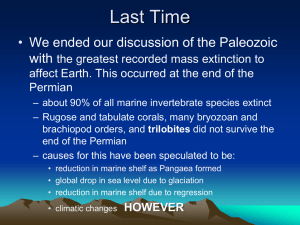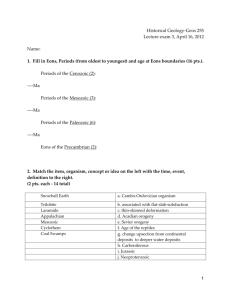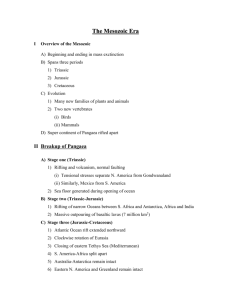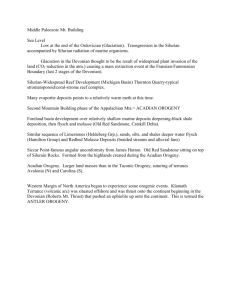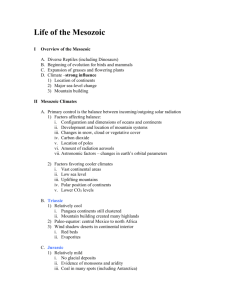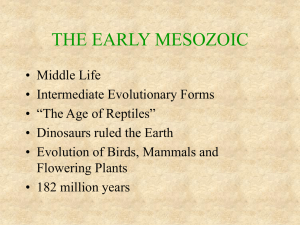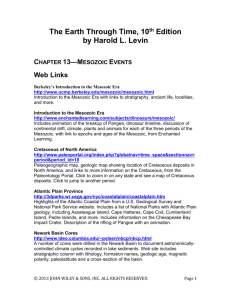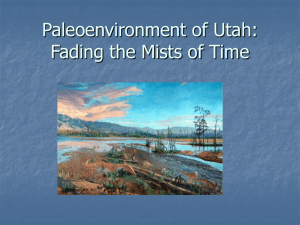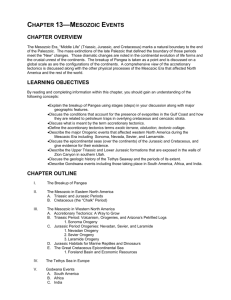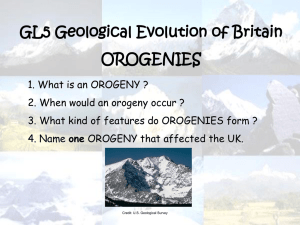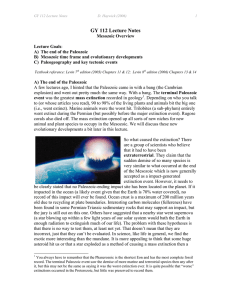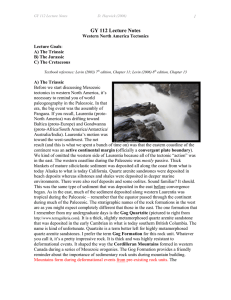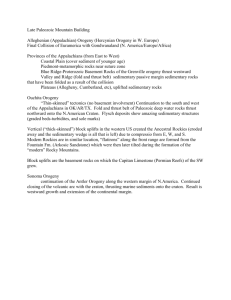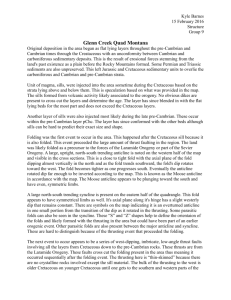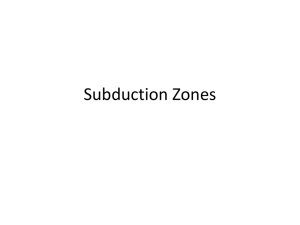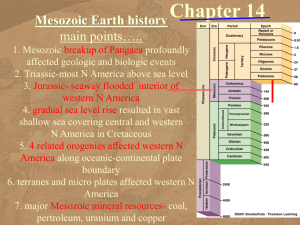4 Mesozoic Geology Homework b
advertisement
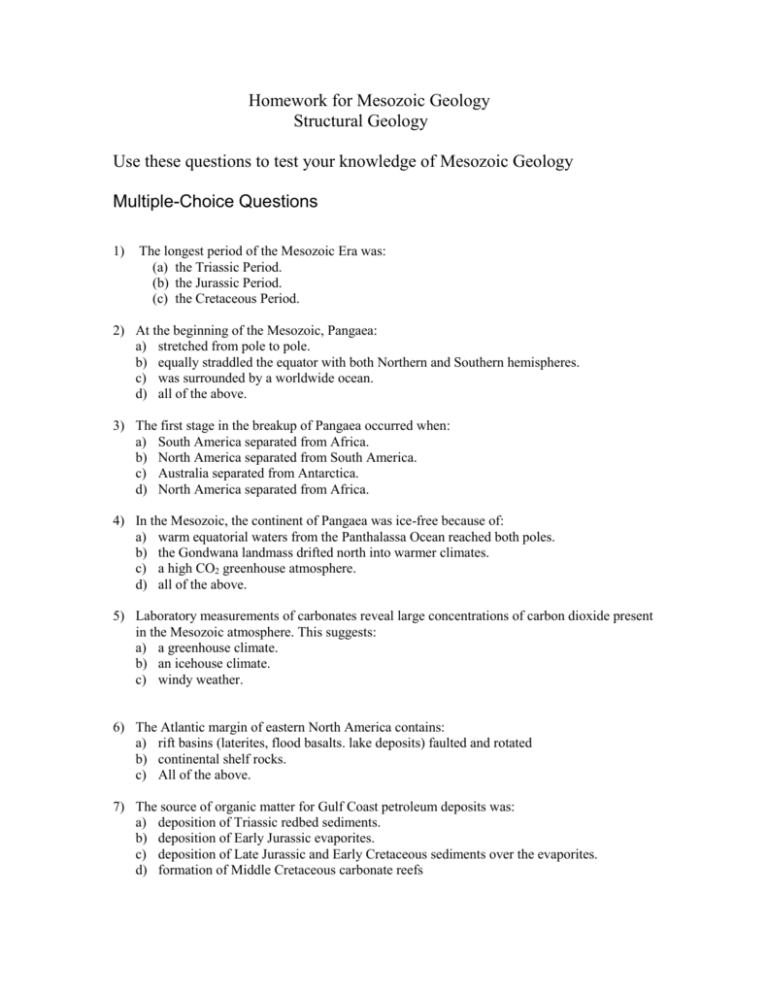
Homework for Mesozoic Geology Structural Geology Use these questions to test your knowledge of Mesozoic Geology Multiple-Choice Questions 1) The longest period of the Mesozoic Era was: (a) the Triassic Period. (b) the Jurassic Period. (c) the Cretaceous Period. 2) At the beginning of the Mesozoic, Pangaea: a) stretched from pole to pole. b) equally straddled the equator with both Northern and Southern hemispheres. c) was surrounded by a worldwide ocean. d) all of the above. 3) The first stage in the breakup of Pangaea occurred when: a) South America separated from Africa. b) North America separated from South America. c) Australia separated from Antarctica. d) North America separated from Africa. 4) In the Mesozoic, the continent of Pangaea was ice-free because of: a) warm equatorial waters from the Panthalassa Ocean reached both poles. b) the Gondwana landmass drifted north into warmer climates. c) a high CO2 greenhouse atmosphere. d) all of the above. 5) Laboratory measurements of carbonates reveal large concentrations of carbon dioxide present in the Mesozoic atmosphere. This suggests: a) a greenhouse climate. b) an icehouse climate. c) windy weather. 6) The Atlantic margin of eastern North America contains: a) rift basins (laterites, flood basalts. lake deposits) faulted and rotated b) continental shelf rocks. c) All of the above. 7) The source of organic matter for Gulf Coast petroleum deposits was: a) deposition of Triassic redbed sediments. b) deposition of Early Jurassic evaporites. c) deposition of Late Jurassic and Early Cretaceous sediments over the evaporites. d) formation of Middle Cretaceous carbonate reefs 8) Formation of the Gulf Coast petroleum deposits can be attributed to: a) deposition of Triassic redbed sediments. b) deposition of Early Jurassic sandstones c) deformation of Late Jurassic and Early Cretaceous sediments by squeezed-up evaporites. d) formation of Middle Cretaceous rudist reefs 9) Which Milankovitch cycle had the greatest period length? (a) Earth’s axial wobbling. 26K (b) Earth’s orbital eccentricity. 100K (c) Earth’s axial tilt. 41K 10) After a detailed structural and stratigraphic study of the western margin of North America, it was realized that many problems in correlation were brought on by the presence of numerous: (a) thrust faults. (b) displaced terranes. (c) rift basins. (d) magmatic arcs. 11) All of the following orogenies represent episodes of the Cordilleran Orogeny EXCEPT: (a) the Nevadan Orogeny. (b) the Sonoma Orogeny (c) the Sevier Orogeny. (d) the Laramide Orogeny. 12) The Late Triassic to Late Jurassic Nevadan Orogeny is characterized by: (a) uplift of basement rocks. (b) thin-skinned tectonics. (c) westward-dipping subduction. (d) massive crustal intrusions (batholiths). 13) The Cretaceous Sevier Orogeny is characterized by: (a) uplift of basement rocks. (b) thin-skinned tectonics. (c) westward-dipping subduction. (d) massive crustal intrusions. 14) The cause of compression during the Sevier Orogeny may be the docking of: (a) Wragellia. (b) Sonomia. (c) Klamathia. 15) The Late Cretaceous to Early Tertiary Laramide Orogeny was characterized by: (a) near vertical uplift of blocks of basement rocks.. (b) thin-skinned tectonics. (c) westward-dipping subduction. (d) massive crustal intrusions. 16) Which caused of Late Cretaceous marine transgression? (a) Rapid rates of sea-floor spreading. (b) Glacial melting. 17) Sediments of the Great Valley Group were deposited: (a) in the foreland basin. (b) in the forearc basin.. (c) as the accretionary wedge. (d) in the magmatic arc. 18) Sediments of the Franciscan Group were deposited : (a) in the foreland basin. (b) in the forearc basin. (c) as the accretionary wedge. (d) in the magmatic arc.
